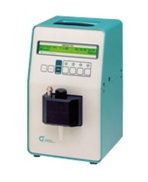Flow-Properties of Lubrication Grease according to Kesternich (DIN 51805)
MINITEST FFK automatically determines the flow-pressure properties of lubricating grease at low temperatures down to -50°C by means of the Kesternich test. The original and time-consuming method is now fully automated and the measuring range is extended far below the original one, resulting in a considerably improved test precision.
A powerful two stage Peltier element avoids the use of a large and expensive cryostat. The principle of the test is based upon the necessary pressure build-up to press an amount of grease through a standard test nozzle at a preset temperature.
ADVANCED TECHNOLOGY
The original manual and time-consuming method is now fully automated in MINITEST FFK. The measuring range is extended far below the original test method.
Temperature control is performed with Peltier elements and eliminates the use of a large and expensive cryostat. No further accessories are necessary.
SAMPLE HANDLING
A layer of the grease to be tested is put on a glass plate without air bubbles. The measuring nozzle is then pressed multiple times onto the layer of lubrication grease until it is filled with grease. The full nozzle is inserted into the thermostatically controlled aluminum block of the tester and the chamber is air sealed.
TEST-PARAMETERS
The test temperature and the equilibrium time are programmed. Further the expected flow pressure and the pressure increase for each step. For high flow pressures, a starting pressure above barometric can be set to limit the measuring time.
MEASURING PROCEDURE
The test temperature, equilibrium time, expected flow pressure and the pressure increase for each step are programmed. For high flow pressures, a starting pressure above barometric can be set to limit the measuring time. The test is performed fully automatically. When the test temperature is reached, the equilibrium time of up to two hours is started. After the equilibrium time, the pressure above the sample nozzle is increased in steps until a sudden pressure decrease, indicating that the grease is pressed through the nozzle. The test is stopped and the last pressure value is displayed as the flow pressure according to Kesternich.
APPLICATIONS
Flow-properties of lubrication grease at low temperatures are a measure of great significance for central lubrication systems of vehicles and machineries. This property can best be measured according the method of Kesternich.
This test method is suitable for temperatures at which no grease leaks out of the test nozzle.
MINITEST FFK is an instrument for the determination of the flow pressure of lubricating greases at temperatures down to "-50°C (- 58°F)."







